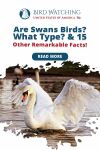
What’s This Post About?
Swans stay true to their status as beautiful birds. Their white feathers, lengthy and curvy necks make them stand out amid the lakes they inhabit. They are giant birds that can weigh up to 30 pounds and range in length from 56 to 62 inches. If you keep them in a protected environment, they are recorded to live for up to 30 years.
These exceptional birds are known for the love they have for their partners. They mate for life except for instances where their partner dies, then they seek out other swans. In the case their partner passes away, there are chances that they too will die of heartbreak. Additionally, they are considered mythological creatures that tend to sing when they are dying.
Swans are birds. They belong to the Anatidae family, which includes the genus Cygnus. Geese and ducks are the closest relatives of swans. Swans belong to the Anserinae subfamily, where they compose the Cygnini tribe.

Swans are magnificent waterbirds known for many things other than their universal symbolism for love and loyalty. They’re big and heavy and are the largest flying waterbirds. They weigh about 11—15 kg, depending on the species.
What is a Swan’s Structure like?
What are some of the stand-out characteristics of these beautiful birds?

The necks of swans are long and curved. Swans’ bodies are sleek, and they have webbed feet. A swan’s body has around 25,000 feathers. Swans have beaks that feature sawlike edges resembling teeth alongside powerful wings that spread 10 feet or 3 meters.
All the swans, more or less, share the same structure and function with little to no variation in physical attributes; however, some physical features set them apart from one another. For example, the color of their plumage, beak, and feet tends to vary across the species.
The duck-goose family’s most significant members are swans. Swans in the polar regions have white or orange colored beaks. However, colors may vary across species as every species of swans has different colored beaks; the beaks of southern swans are red, orange, or black and a combination of white and black.
Australia and New Zealand are the only two countries black swans are native to. Additionally, the “black-necked” swans of South America have white bodies and black necks. These swan’s legs are gray/blackish, while other swans native to South America have reddish-pink feet.
What are the Mating Habits of a Swan?

Swans are known for their lifelong companionship. However, if one of the mates dies, the swan will find a new partner. Mating begins with a display in which a couple of swans tilt their heads and flap their wing simultaneously. The mating procedure might last a few seconds to over half an hour.
The mating process for swans is slow and more drawn out because these birds take their time in displays they make for each other, which are exaggerated to maintain and reinforce the established bond that the pair has.
Swans mate and nest near freshwater bodies such as lakes, ponds, marshes, and slow-moving rivers. These birds may start mating when they’re two or three years of age. The mating process begins in winter. At times swans don’t find a mate to form a pair with till they’re seven years of age.
DID YOU KNOW?
Swans are highly loyal, and there is only a five percent chance of them ever splitting up.
What Behaviors do Swan’s Showcase?

Swans exhibit several behaviors throughout their lifetime—they are both mid-boggling as well as interesting; from showing aggressiveness to getting over-protective, these swans have a way of carrying themselves when they’re in the wild.
First, let’s look into their migratory behavior. Several species of swans are migratory or partially migratory, while others spend their whole lives in one location. Fully migrating swan species tend to migrate during winters, whereas partially migratory swans migrate for food resources.
Swans often show aggressiveness towards perceived threats; they hiss and attack when they sense a threat to keep them away from their nesting space and little cygnets. After scaring away a threat, swans produce loud, deep, ‘trumpet-like’ sounds and flap each other’s wings in a ‘high-five’ motion.
INTERESTING FACT
If you ever find yourself wondering what a flock of wild swans is called, then you must know that it's called a bevy.
Due to their enormous size, swans have few dangers in the wild. The only predators they have to keep an eye out for are snapping turtles, horned owls, and snakes—these animals actively prey on swans’ eggs.
Humans, who hunt them for their flesh, skin, and feathers, are the primary predators of swans. Raccoons, wolves, and foxes are other predators that feast on their meat as well as their babies.
Swans may sleep on land as well as in the water. Another interesting behavior observed was that black swans could swim using one leg only.
DID YOU KNOW?
Swans can fly at speeds of up to 60 miles per hour.
What are a Swan’s Eating Habits?

Swans consume water plants, which they can gather from the riverbank with the help of their long necks. They also consume tiny fish, worms, and frogs, as well as mollusks that cling to the plants. They will graze large grassy areas and can even thrive in a narrow field of grass.
Swans are omnivore birds, although their diet consists primarily of plants. Underwater, they consume aquatic plants and seaweed, whereas, on land, they devour stems, seeds, and berries. Swans are also known to eat tadpoles, tiny fish, insects, and worms.
FUN FACT
Swans can live for up to thirty years if properly taken care of.
15 Remarkable Facts About Swans
Following are some unique and fascinating facts about Swans!

- Water pollution is an imminent threat to Swans. The danger of pollution has been lurking around for a long time, and with pollution growing in their habitat, they are at risk of dying.
- An interesting fact you should know is that swans tend to part ways if nestling fails. Although the chances of this happening are pretty rare as these birds are monogamous and mate for life, studies show that this has been a cause of ‘divorce’ between several pairs of swans. The divorce rate of swans is only a measly five percent.
- A unique picturesque occurrence observed is the swans’ iconic kiss; their elongated necks form the shape of a heart. This is quite an image and a beautiful sight to look at. If you have swans nearby, you might be able to witness it often, but only if you look long enough for it to happen.

- During molting season, which occurs in the summer for swans, they shed off their old feathers, and new ones grow in their place. Within a year, most likely, all the feathers get replaced.
- The British Crown claims rights to all unmarked swans on open water in the UK under the royal prerogative. To put it in simple words, they own all the possible swans that exist on the British seas. Therefore, you cannot claim or hunt one down even if you wanted to.

- Swans fall prey to different pet and animal industries/markets that hunt them down for their feathers and skin—they are often used as decorative pieces in parks with lakes and ponds. Isn’t that strange?
- Swans are thought to be clever creatures that recall who has been good to them and who has not. They have the ability to recognize human faces and have a solid memory when it comes to keeping track of their friends and enemies.

- An instance occurred in 2001, which was that of a Swan breaking the leg of a man who was persistently provoking it. The swan ended up attacking the human, which resulted in his leg getting broken.
- Swans of all ages have different names that they are known by, and the names are unique for both sexes. A female swan is called a pen, while a male swan is called a cob. The baby swan is known as a cygnet.
- Courtship dances accompany a range of grunting and hissing noises during the mating season. During the process, some swans tend to sing or honk and participate in synchronized swimming and head tilting.
- Swans have very few natural predators due to their large size. Foxes, wolves, and raccoons are natural predators of swans and their eggs.
- The swan population has been declining over the years due to the ongoing pollution, hunting, and the destruction of their natural habitat.

- The Black swan, Black-necked swan, Mute swan, Tundra swan (including Bewick and Whistling swan), Trumpeter swan, and Whooper swan are among the swan species that vary in size, color, and behavior.
- Greenland, Iceland, Scandinavia, Central Asia, Russia, Japan, and China are all destinations for migratory swans.
- Swans prefer temperate and oceanic climates because the winters in those regions are never too cold.

KEEP READING!
Swans, as previously mentioned, are members of the Anatidae family, and the closest relatives of swans are geese and ducks. Swans are members of the Anserinae subfamily and the Cygnini tribe. They are massive birds that glide across the water and fly by beating their wings slowly.
These extraordinary birds are well-known for their devotion to their mates. They mate for life until their spouse dies, in which case they seek out other swans. If their lover dies, there is a risk that they will die of sorrow as well. Additionally, they are legendary beings who are known to sing as they pass away.
We hope the facts mentioned above piqued your interest. These are magnificent creatures that have a lot to offer other than just their beauty. If you are keen on learning more about birds, here is a post on bluebirds , including over 30 fun facts for you to enjoy. Be sure to check it out!
30 Amazing Bluebird Facts You Probably Didn't Know (2021)
Is the bluebird territorial or social, or both? You will be fascinated to find out what these lovely birds are capable of doing!

By David A. Swanson
Bird Watching USA
My name is David and I'm the the founder of Bird Watching USA! I started Bird Watching with My father-in-law many years ago, and I've become an addict to watching these beautiful creatures. I've learnt so much over about bird watching over the years that I want to share with the world everything I know about them!

David A. Swanson
Bird Watching USA
My name is David and I'm the the founder of Bird Watching USA! I started Bird Watching with My father-in-law many years ago, and I've become an addict to watching these beautiful creatures. I've learnt so much over about bird watching over the years that I want to share with the world everything I know about them!



